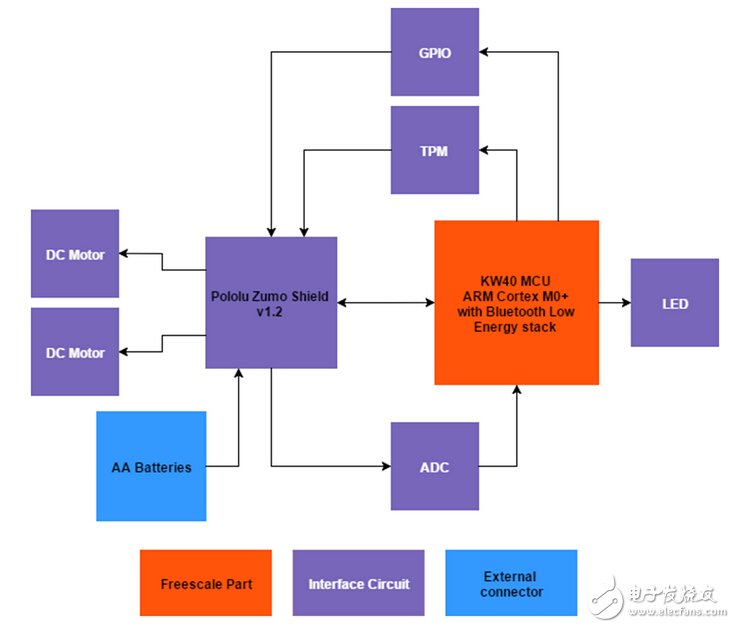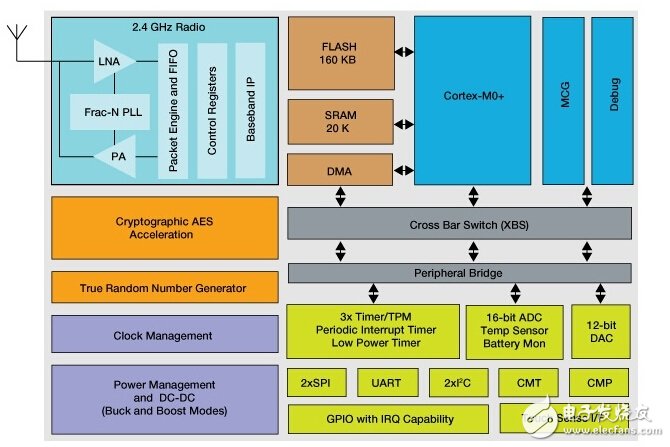NXP Low Power Bluetooth Control Robot Reference Design
The Bluetooth® Low Energy (BLE) controlled robotic reference design was developed using the FRDM-KW40 board and the Pololu Zumo robot and can be controlled via the mobile app. The BLE-controlled robot is based on the KineTIs KW40Z System-on-Chip (SOC), which includes an ARM® Cortex® M0+ processor with a 2.4 GHz radio for BLE and 802.15.4. It is implemented using the HID over GATT configuration file and is used as a human interface device. Features provided by the software include: BLE data to mobile app transfer, motor control and battery monitoring, and more.
1. Low-power Bluetooth controlled robot system block diagram

2. Low-power Bluetooth controlled robot reference design features
These include NXP's ultra-low-power KineTIs KW40Z SoC, which provides Bluetooth® Smart/Bluetooth® Low Energy (BLE) v4.1 and/or IEEE® 802.15.4-2011 for portable, ultra-low power embedded systems. RF connection
Developed with the KineTIs Software Development Kit (SDK), providing comprehensive software support for KineTIs MCUs, including a hardware abstraction layer (HAL), drivers for each MCU peripheral, connection stack, middleware, real-time operating system, and application examples. Designed to simplify and accelerate application development based on Kinetis microcontrollers.
3, support devices
KW40Z: Kinetis® KW40Z-2.4 GHz dual mode: BLE and 802.15.4 wirelessly connected microcontroller (MCU) based on ARM® Cortex®-M0+ core
The KW40Z is a highly integrated, single-chip device that enables portable, ultra-low-power embedded systems with Bluetooth® Smart/Bluetooth® Low Energy (BLE) v4.1 and IEEE® 802.15.4-2011 RF connectivity. Applications include portable medical devices, wearable sports and fitness equipment, AV remote controls, computer keyboards and mice, game controllers, access control, security systems, smart energy and home networking.
The KW40Z MCU integrates a 2.4 GHz transceiver supporting multiple FSK/GFSK and O-QPSK modulations, an ARM® Cortex®-M0+ processor, 160 KB flash and 20 KB SRAM, BLE link layer hardware, 802.15.4 packets The processor, hardware security and peripherals are optimized to meet the requirements of the target application. The KW40Z has enough on-chip memory to run both the Bluetooth Low Energy stack and the IEEE 8021.5.4 MAC/PHY for multimode applications.

KW40Z structure block diagram
characteristic
Multi-protocol radio:
Compliant with 2.4 GHz Bluetooth Low Energy V4.1
Compliant with IEEE Std. 802.15.4-2011 standard
Typical Receive Sensitivity (BLE) = -91 dBm
Typical Receive Sensitivity (802.15.4) = -102 dBm
Transmit output power can be set from -20 dBm to +5 dBm
Kernel and memory aspects:
Up to 48 MHz ARM® Cortex-M0+ core
On-chip 160 KB flash
On-chip 20 KB SRAM
Low power consumption, operating voltage range:
9 low power modes, optimized power supply based on application requirements
Typical Receive/Transmit Current (DC/Support DC): 6.5 mA / 8.4 mA
Bypass voltage: 1.71V to 3.6V
DCDC converter step-down configuration: 2.1V to 4.2V
DCDC converter boost configuration: 0.9V to 1.795V
Analog module:
16-bit analog-to-digital converter (ADC)
12-bit digital-to-analog converter (DAC)
6-bit high speed analog comparator (CMP)
safety:
AES-128 Accelerator (AESA), True Random Number Generator (TRNG)
Support software:
BLE host protocol stack and configuration file, 802.15.4 MAC and SMAC
Kinetis® Software Development Kit (SDK)
FreeRTOS kernel and bare metal non-preemptive task scheduler
Three-phase current and voltage transducers are mainly used to isolate the measured
current and voltage signals and output one or two analog signals or digital signals.
Three Phase A/V Transducer,Three Phase Current Transducer,Three-Phase Ac/Dc Instrument Transducer,3 Phase Voltage Transducer
Jiangsu Sfere Electric Co., Ltd , https://www.elecnova-global.com